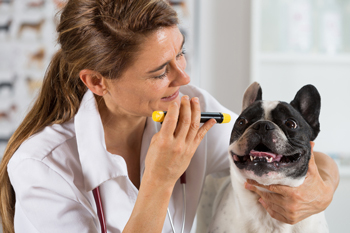Anterior Uveitis in Dogs

The uvea, between the cornea and the retina, contains several important structures, including the iris, ciliary body, and choroid. It helps nourish both the retina and the cornea, and the iris controls how dilated the pupil is and, thus, how much light gets into the eye.
Anterior uveitis is inflammation of the uvea.
Causes of Canine Anterior Uveitis
Uveitis commonly occurs as a secondary complication of something going on elsewhere in the body. Some of those primary causes include:
- Metabolic diseases like diabetes mellitus
- Infections like distemper, Lyme disease, and leptospirosis
- Heartworm disease
- Autoimmune disease
Uveitis may also occur due to a local problem with the eye itself, including:
- Tumor
- Trauma
- Secondary to cataracts
Finally, anterior uveitis in dogs may be idiopathic, which means that no underlying cause can be identified.
Signs of Anterior Uveitis in Dogs
Anterior uveitis is painful for dogs, so you will usually see signs of pain when they have it, along with several other indications.
- Pawing at the eyes or rubbing them on things
- Squinting
- Redness in the whites of the eyes
- Ocular drainage
- Small or oddly-shaped pupil
- Cloudy appearance to the eye
Diagnosis of Canine Anterior Uveitis
If you see any problem with your dog's eye, make an appointment with your veterinarian right away. In order to diagnose anterior uveitis, the doctor will talk with you to obtain a full medical history. Then, he or she will do a thorough physical examination, including an eye evaluation.
The veterinarian will measure the IOP (intraocular pressure) of your dog's eye with a tonometer. Pressure is often abnormally low in dogs with uveitis.
Other tests such blood and urine tests and ultrasound may be used to help diagnose any underlying condition once uveitis is diagnosed. Your dog may also be referred to a veterinary ophthalmologist.
Treatment of Anterior Uveitis in Dogs
Eye drops to control pain and inflammation are usually prescribed to a dog with anterior uveitis. From there, if an underlying cause has been identified for the uveitis, that will need to be treated.
Glaucoma, or high IOP, is a common complication of uveitis, so your veterinarian will want to treat the uveitis aggressively and recheck your dog often during uveitis treatment.
You May Also Like These Articles:
A General Guide to Puppy Safety
Canine Epilepsy: Seizures in Dogs
Restrain Your Dog While Driving
A Hidden Laundry Room Danger for Dogs: Laundry Pods
Things We Do That Annoy Our Dogs - Slideshow
Quiz - Test Your Cold Weather Dog Knowledge
Disclaimer: This website is not intended to replace professional consultation, diagnosis, or treatment by a licensed veterinarian. If you require any veterinary related advice, contact your veterinarian promptly. Information at DogHealth.com is exclusively of a general reference nature. Do not disregard veterinary advice or delay treatment as a result of accessing information at this site. Just Answer is an external service not affiliated with DogHealth.com.
Notice: Ask-a-Vet is an affiliated service for those who wish to speak with a veterinary professional about their pet's specific condition. Initially, a bot will ask questions to determine the general nature of your concern. Then, you will be transferred to a human. There is a charge for the service if you choose to connect to a veterinarian. Ask-a-Vet is not manned by the staff or owners of DogHealth.com, and the advice given should not delay or replace a visit to your veterinarian.


